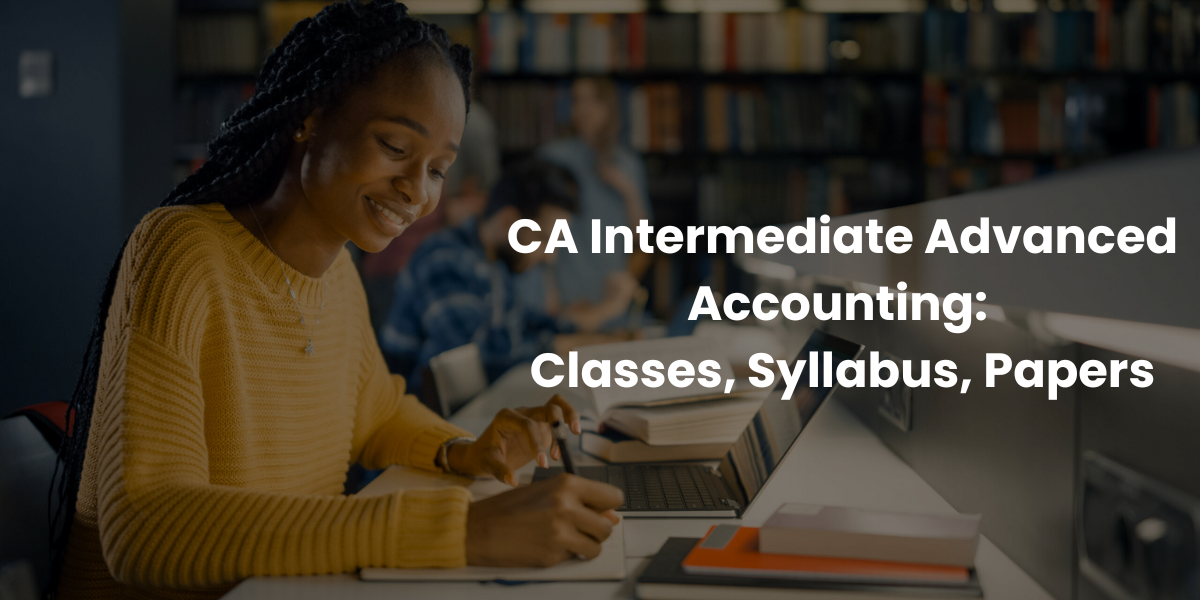CA Intermediate Exam Form May 2025, Registration Last Date, Process Exam Fee, and New Course Details
Introduction
The CA Intermediate exam is a crucial milestone for students pursuing the Chartered Accountancy (CA) course. The Institute of Chartered Accountants of India (ICAI) conducts this examination three times a year—in May, September, and January. For candidates preparing for the upcoming attempt, staying updated with the CA Intermediate exam form May 2025, registration details, exam fees, and other key information is essential.
Candidates can conveniently fill out the CA Intermediate May 2025 exam form online through the official ICAI website: icai.org. The entire process is straightforward, ensuring hassle-free registration for all aspiring CAs.
Scheduled Dates for CA Inter May 2025 Exams
The CA Intermediate exam is divided into two groups, each containing four papers. Below is the detailed schedule for the CA Intermediate exams 2025:
Group I Exam Schedule
| Date | Paper | Time |
|---|---|---|
| May 3, 2025 | Paper 1 | 2:00 PM – 5:00 PM |
| May 5, 2025 | Paper 2 | 2:00 PM – 5:00 PM |
| May 7, 2025 | Paper 3 | 2:00 PM – 5:00 PM |
Group II Exam Schedule
| Date | Paper | Time |
|---|---|---|
| May 9, 2025 | Paper 4 | 2:00 PM – 5:00 PM |
| May 11, 2025 | Paper 5 | 2:00 PM – 5:00 PM |
| May 14, 2025 | Paper 6 | 2:00 PM – 5:00 PM |
Important Dates for CA Intermediate Exam Form May 2025
Students must be well-prepared and keep track of any updates regarding the CA Intermediate date sheet to avoid missing any deadlines.
Inter Exam Schedule
| Date | Day | Event |
|---|---|---|
| March 1, 2025 | Saturday | Commencement of submission of online examination application forms |
| March 14, 2025 | Friday | Last date for submission of online examination application forms (without late fees) |
| March 17, 2025 | Monday | Last date for submission of online examination application forms (with late fees of ₹ 600/- or US $ 10) |
| March 18, 2025 to March 20, 2025 | Tuesday to Thursday | For students seeking a change of examination city/medium, the correction window for the examination forms already filled will be available during these dates |
CA Inter Exam Pattern
The CA Intermediate exam assesses candidates’ fundamental and practical understanding of key subjects such as accounting, cost management, taxation, auditing, and financial management. Each paper is worth 100 marks, and to pass, students must secure a minimum of 40% in each subject and an overall aggregate of 50%. Additionally, multiple-choice questions (MCQs) do not have any negative markings.
Exam Details
| Type of Questions | Both Descriptive and Objective Papers |
|---|---|
| Mode | Offline |
| Language | English / Hindi |
| MCQs | 20% in 4 exams |
| Negative Marking | No |
| Total Marks | 100 |
| Number of Questions | 6 (First compulsory + attempt any four from rest of the five) |
| Exam Duration | 3 hours |
Documents to Carry for CA Inter Exams
Candidates appearing for the CA Inter May 2025 exam must carry the following essential documents:>
- Hard Copy of ICAI Admit Card: (Only available for download three times, so multiple photocopies are advisable).
- Valid Identity Proof: (Aadhar Card, Driving License, Passport, or any government-issued ID). The name on the ID must match the admit card.
- Two Passport-Sized Photographs: (In case an additional photograph is required for verification).
- Note: Entry to the exam hall will be strictly prohibited without these documents.
How to Fill CA Inter Exam Form for May 2025
- Visit the official ICAI website and log in to the SSP Portal (Student Service Portal) using your ICAI registration number (e.g., SRO/WRO, etc.).
- If you have forgotten your password, you can retrieve it by using the Forgot Password option.
- Once logged in, a form will appear where you will need to enter your exam-related details, select your preferred exam center, and then click on Save and Proceed.
- Complete the process by making an online payment of the examination fee, which ranges between Rs. 1,500 to Rs. 2,700, depending on the number of groups selected.
ICAI Exam Correction Window
It is crucial to fill in all details accurately while submitting the exam form. However, after the submission window closes, ICAI provides a correction window for a limited period. During this time, students can rectify any errors, such as incorrect exam center selection or language preference, by making the necessary changes on the official ICAI website.
Examination Fees for CA Inter Exam May 2025
The CA Intermediate registration fees vary based on the number of groups a student registers for and their nationality. Below is the detailed fee structure for both Indian and foreign students:
CA Intermediate Fee Details
| Fee Description | Both Groups | Single Group (I / II) | Fee Amount for Indian Nationals (₹) | Fee Amount for Foreign Nationals ($) |
|---|---|---|---|---|
| CA Intermediate Registration Fees | ₹ 15,000 | ₹ 11,000 | $ 1000 | $ 600 |
| Student’s Activity Fees for CA Intermediate (One-Time Payment) | ₹ 2,000 | ₹ 2,000 | – | – |
| CA Intermediate Registration Fees (as article assistant) | ₹ 1,000 | – | – | – |
| Cost of Prospectus (Direct Entry Students) | ₹ 200 | ₹ 200 | $ 20 | $ 20 |
| CA Intermediate Exam Form | ₹ 2,700 | ₹ 1,500 | $ 500 | $ 325 |
| Total CA Intermediate Fees | ₹ 20,900 | ₹ 14,700 | $ 1520 | $ 945 |
CA Intermediate May 2025 Exam Guidelines
ICAI has outlined strict guidelines for candidates appearing in the CA Inter May 2025 exam:
- Maintain discipline: Candidates must maintain discipline in the examination hall.
- No digital devices: Digital devices, cheating, or communication with other candidates is not allowed.
- Disqualification: Invigilators have the power to disqualify any candidate caught violating the rules.
- Bring your own materials: Students should bring their own pens, pencils, erasers, and calculators. Borrowing from others is prohibited.
- No extra sheets: No extra sheets for rough work will be provided.
- Write necessary details: Candidates must write their roll number, question code, and other details on the answer booklet.
- Exit restrictions: Students can only leave the examination hall after a specific duration of the exam has passed.
Contact Details for the ICAI Examination Department
For any queries or concerns regarding the CA Intermediate Examination, candidates can contact the Institute of Chartered Accountants of India (ICAI) through the following channels:
Address:Additional Secretary (Exams)
The Institute of Chartered Accountants of India
ICAI Bhawan, Post Box No. 7112
Indraprastha Marg, New Delhi – 110 002
Helpline Numbers:
- 0120-3054 851
- 0120-3054 852
- 0120-3054 853
- 0120-3054 835
- 4953 751
- 4953 752
- 4953 754
Email: intermediate_examhelpline@icai.in
Candidates can use these contact details for any assistance or clarification regarding the CA Intermediate Examination.
Preparation strategy for CA Inter Exams
Acing the CA Intermediate May 2025 exam requires a well-planned study strategy. Here’s how candidates can prepare effectively:
- Create a Study Plan: Allocate time for each subject, prioritizing weaker areas. Ensure a balance between theoretical and practical subjects.
- Use ICAI Study Material: ICAI’s official study material and practice manuals are crucial for exam preparation. Stick to them and solve the exercises provided.
- Take Mock Tests: Mock tests simulate real exam conditions and help improve time management and accuracy.
- Revise Regularly: Set aside time for multiple revisions before the exam. Rewriting notes and summarizing key concepts helps reinforce memory.
- Focus on Conceptual Clarity: Instead of rote learning, understand the underlying concepts. This approach is particularly useful for practical subjects like Accounting and Costing.
- Practice Past Papers: Solve previous years’ question papers to identify patterns in ICAI’s questioning style and focus on frequently tested topics.
- Join CA Classes: Professional coaching or online CA classes can provide structured guidance and doubt-clearing sessions.
- Maintain a Healthy Routine: Proper sleep, a balanced diet, and stress management techniques like meditation can enhance focus and productivity.
FAQ’s
What is the last date to register for the CA Intermediate May 2025 exam?
According to the latest information, the last date to register for the CA Intermediate May 2025 exam is March 14, 2025 without late fees, and with a late fee option until March 17, 2025.
How can I fill out the CA Intermediate May 2025 exam form?
You can fill out the CA Intermediate exam form online by visiting the ICAI official website (www.icai.org). Login with your credentials, fill in the required details, upload necessary documents, pay the exam fee, and submit the form before the deadline.
What is the exam fee for CA Intermediate May 2025 attempt?
CA Intermediate Exam Fee Details – May 2025
| Group | Fee for Indian Students (₹) | Fee for Foreign Students ($) |
|---|---|---|
| Single Group | ₹ 1,500 | $ 325 |
| Both Groups | ₹ 2,700 | $ 500 |
| Note: Additional late fees may apply if the form is submitted after the initial deadline. | ||
>
What are the changes in the CA Intermediate syllabus for May 2025?
Under the New Scheme of Education and Training, ICAI has revised the syllabus with updated subject content, paper structure, and weightage. Some key changes include the removal of old subjects, restructuring of existing topics, and increased focus on practical applications. Candidates should refer to the latest ICAI study materials for detailed updates.










